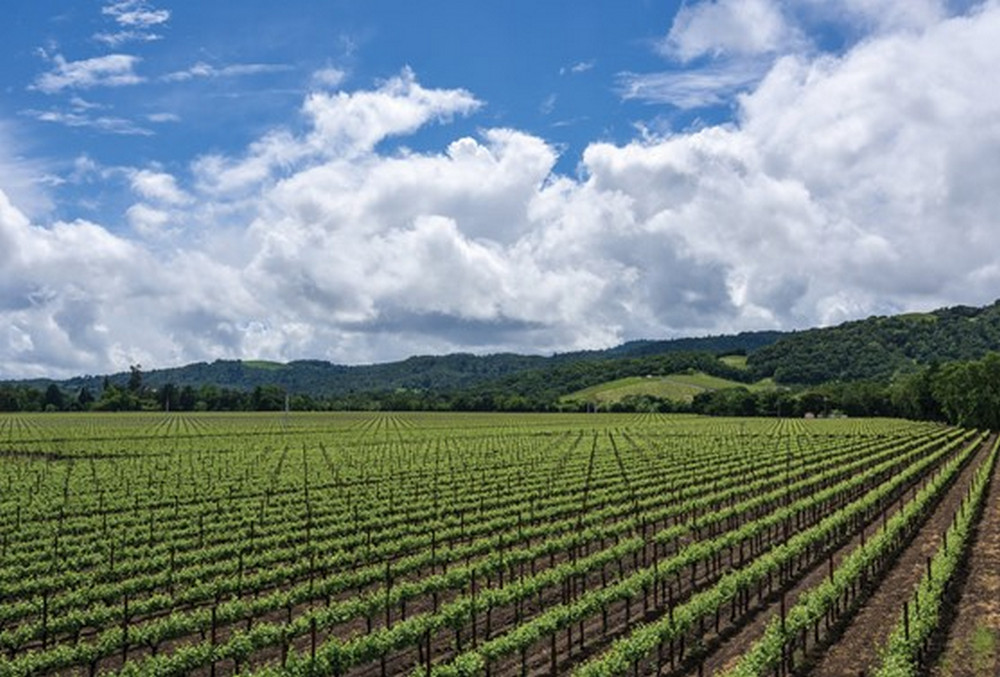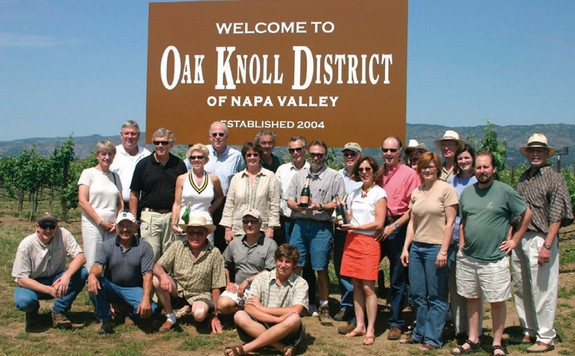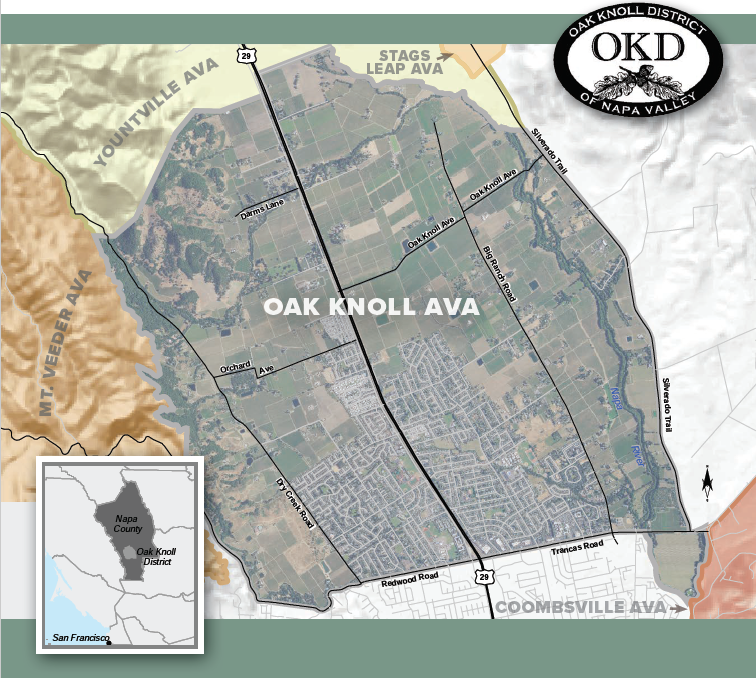Napa Varietal Series + SIP
Oak Knoll District AVA
Published On: October 28, 2020

Napa Valley’s Sweet Spot
Most of Napa Valley’s AVA’s are renowned for growing a particular variety. The Oak Knoll District AVA, on the other hand, is distinguished by its diversity. As many as 15 different grape varieties are grown within its 8,300 acres, of which half are planted to vine. From A to Z – Albariño to Zinfandel – this incredible range lends to its designation as the ‘sweet spot’ of Napa Valley.
Located north of the City of Napa and south of Yountville, the Oak Knoll District AVA (OKD), formally recognized in 2004 as Napa’s 14th American Viticultural Area, is bordered to the west by Mt. Veeder and the east by the Silverado Trail. A quieter district than other AVAs due to its less commercialized nature, it is populated by dozens of small-scale growers and only a handful of brick and mortar wineries. Some of Napa Valley’s most prestigious brands make their home here, and many of Napa Valley’s premier winemakers source fruit from these vine- yards. Of note, Calistoga-based Chateau Montelena’s historic Judgment of Paris Chardonnay winner contained grapes sourced from OKD. And the 1979 World Wine Olympics held in Paris named OKD-based Trefethen Family Vineyards’ 100% OKD Chardonnay as number one in the world.
Warm weather perfectly ripens OKD’s reds, while morning fog cools its whites. This marine- influenced climate pattern is essential for preserving aromatics in the grapes and wine. The region’s sand, gravel, and clay region. “Even though the area looks fairly uniform, the magic in OKD occurs underground where an incredible variety of soil types, textures, and depths creates enormous variation that you can’t see when standing on it,” said vineyard manager Doug Hill of Oak Knoll Farming. Hill discovered over time and with experimentation that OKD could even produce Merlots that stand-up next to Right Bank Bordeauxs. “I am amazed at the variety and consistency this appellation can produce.”

Rodgers Vineyards, located just off of Hwy 29, is a quintessential example of the region’s vinous multiplicity. Sixth genera- tion growers, the Rodgers family cultivates Cabernet, Syrah, Merlot, Chardonnay, Pinot Noir, Viognier, and Zinfandel grapes on its OKD ranch. “It is incredible to farm such diverse varieties, some separated by just a vineyard avenue,” said Rodgers’ president, CEO, and vineyard manager Anna Hickey, fifth-generation descendent of Portuguese im- migrants who helped to establish the OKD. “We have our Pinot Noir, a touchy creature, sitting across from Merlot and next to Cabernet. Changing hats or strategies is an expectation of farmers, but in the case of OKD farming, your hat and strategy may change from block to block on a given day. The challenges of farming in the OKD are real, but the gifts of such diverse farming are just as real.”
Those gifts are fabulous wines. “Freshness, brightness, and purity of varietal character are what I consider to be basic traits of OKD wines,” said OKD-born and raised Dave Pramuk, recently retired founding partner and current board member of the AVA’s Robert Biale Vineyards. “Many winemakers use OKD fruit to freshen up blends that may lack acidity and aromatics. Our OKD Zinfandels at Biale, for instance, have always been praised as being more balanced and elegant than expected for the varietal. The cooler climate helps maintain acidity and time to develop flavors and color.”

“One of my chief attractions to OKD is that acidity,” added Bryan Kays, winemaker at Trefethen Family Vineyards. “Due to our location in the valley, our grapes retain a bit more acidity, which keeps the resulting wine quite fresh. The wines are very versatile on the table and tend to have great age ability.”
“Amazingly, you can grow so many varieties so success- fully here, and it’s largely due to soil and climate,” said Janet Trefethen, proprietor of Trefethen, and co-president of the OKD. “The fog rolls in from San Francisco Bay toward Wappo Hill, entering the mouth of the Valley. More fog rolls off San Pablo Bay along the Napa River and provides the strongest influence in this southern end of the valley. On a typical summer day, you can leave OKD with a sweater, and for every mile north, it gets a 1/2 degree warmer. By the time you reach Calistoga, the temperature has increased by 10 degrees. Our cool air does severely limit the crop size of the Cabernet, but it more than repays it with the increased complexity of bouquet in the final bottling. What is critical for the quality of Chardonnay and Pinot becomes a grace note for Cabernet and Merlot. Simply put, soil and climate are the real rationales for why OKD exists.”
Hickey agreed, “The Rodgers family looks at its vineyard value in dirt, not dollars. If we do not love this soil and the environment around it, it will not love us back. I am often asked about sustainability, and my answer is, ‘We’ve been here 151 years!’ We have successfully done this through many generations, and to me, that is true sustainability.” Being able to steward this land and pass it on to another generation of stewards is our goal.”

Beyond soil and climate, OKD’s role in the history of Napa Valley is notable. It was 1850 when the first Zinfandel was planted in its western section, now Lamoreaux Vineyards, the original Oak Knoll Ranch from which the crossroad and region derive their names. At the time, Oak Knoll Ranch was praised in statewide press as a top farm in California. A stone block carriage step engraved with ‘Oak Knoll’ remains in the location as a regional relic. The District also built its name on the old Oak Knoll train stop and Oak Knoll Schoolhouse.
Among other OKD relics is Trefethen’s historic property and ranch, the site of the original Eshcol Ranch. The Trefethen family painstakingly and gorgeously rebuilt and restored the farmhouse and barn after each suffered devastating damage from the 2014 earthquake. “Certainly one of Napa Valley’s and California’s most historic and picturesque structures was saved – a testament to the Trefethen family’s pride and spirit of determination,” said Pramuk, who didn’t fully appreciate the world-class wine nature of his youth until he took a wine class in college and traveled to Europe. “And, where else than at Trefethen can you find exquisite examples of Chardonnay, Bordeaux varietals, and White Riesling grown near each other? It’s remarkable.”
“Our AVA is a bit different in that we have more small growers than vintners, some with three to five acres, and as a result, there’s a great deal of camaraderie,” said Trefethen. “We share stories, comments, tips, and how to do this and that. We all try and help each other. It’s very similar to when we started in 1973. Some of our first events were like a block party; everyone was invited. We often couldn’t get them to leave!”
“Frankly, it’s the people that make this such a unique place to live and work,” said Stan Boyd, proprietor of Boyd Wine, who fulfilled a lifetime dream by purchasing his property in 1998. “We have made numerous lifelong friends. Some of us decided to grow grapes, some decided to launch a wine brand, and some did both. The common thread is a lust for living life to its fullest, and a love of wine.”
Biking also brings many OKD residents together. Boyd and four others formed a bicycle club called the OKD Clydesdales. Together they have logged more than 40,000 Napa Valley miles, always starting and stopping in the OKD. Today the club counts more than 30 active OKD resident members who participate in its rides and social events.
“Case in point!” said Trefethen. “The Oak Knoll District AVA – unique in its diversity – is truly all things to all people.”
FOR MORE INFORMATION
Article By: Fran Miller
